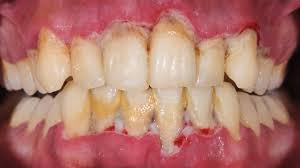32 Forth Crescent, Riverside
Stirling FK8 1LG


Gum disease is a very common condition and can lead to early tooth loss if left untreated.Periodontal disease as gum disease is also known is partly a genetic disease -in other words some patients are susceptible to gum disease due to their genetic makeup.This explains why some patients don’t keep their teeth particularly clean and have a lot of plaque in their mouth but don’t suffer from gum disease.
Conversely other patients do look after their teeth very well but do develop gum disease.Obviously dentists and patients have no control over this but can still reduce the chances of gum disease by keeping their teeth clean.
The key to treating gum disease is eliminating gum inflammation ie removal of bacteria in the plaque by the patient and the dentist.
Patients remove bacteria by tooth brushing mainly and also other methods such as flossing or using interdental brushes.Daily use of antibacterial mouthwash to inhibit plaque formation also helps.
Dentists or hygienists treat inflammation by scaling the teeth and removing plaque and hard calcified plaque called tartar.
The symptoms of gum disease are bleeding gums on brushing at its mildest form or painful ,bleeding infected gums with loosening teeth when more advanced.
When teeth become loose they can be painful to bite on and can eventually be lost.
There are other factors which can make gum disease more likely.Smoking is the single biggest contributing factor to gum problems and also makes them more difficult to treat.Therefore stopping or reducing smoking is always advised at the outset of treatment.
Medical factors such as diabetes,stress,depression and blood deficiencies such as Iron and Vit B12 also make patients more susceptible to gum disease .Also certain medications used for epilepsy and blood pressure are associated with gum disease.
Treatment of gum disease will be discussed in the next blog.
Fields with (*) are required.
Please contact us via this website or email without disclosing confidential information.